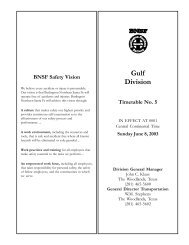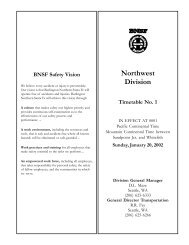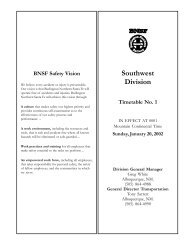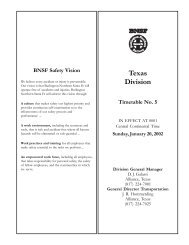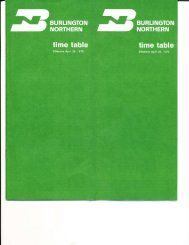2 11/5/03 - Friends of the Burlington Northern Railroad
2 11/5/03 - Friends of the Burlington Northern Railroad
2 11/5/03 - Friends of the Burlington Northern Railroad
You also want an ePaper? Increase the reach of your titles
YUMPU automatically turns print PDFs into web optimized ePapers that Google loves.
72 NORTHWEST DIV.—No. 2—November 5, 20<strong>03</strong>—Stampede Subdivision<br />
sounds. The oversize car will be set out on <strong>the</strong> house track at<br />
Kanaskat to be picked up by next available westbound train.<br />
This information is to be given to <strong>the</strong> dispatcher upon setout.<br />
6. FRA Excepted Track<br />
Palmer Jct. to Veazey—MP 0.6 to MP 6.9<br />
Ellensburg Yard, except siding extension<br />
Cle Elum Yard, except siding<br />
7. Special Conditions<br />
Auburn and Ellensburg—Train Inspections—A member <strong>of</strong><br />
inbound crews on through trains operating cabooseless will<br />
give <strong>the</strong> outbound train a roll-by inspection and advise <strong>the</strong><br />
outbound crew <strong>of</strong> <strong>the</strong> condition <strong>of</strong> <strong>the</strong> train, unless <strong>the</strong><br />
outbound crew will not be immediately available or <strong>the</strong> inbound<br />
crew is o<strong>the</strong>rwise relieved <strong>of</strong> duties.<br />
Close Clearance—May exist on all auxiliary tracks.<br />
Mountain Grade Special Conditions<br />
Between Easton and Lester—Trains handling cars<br />
exceeding Plate E are not permitted except trains handling<br />
doublestack equipment may operate if equipment is bare table<br />
or with containers in bottom well only. Containers are<br />
restricted to single level loading only. Trains handling loaded<br />
TOFC cars must not exceed 10 MPH through Tunnel 4<br />
between MP 49.0 and MP 50.0.<br />
Mountain Grade Operation—Air Brake and Train Handling<br />
Rules for mountain grade operations apply on mountain grade<br />
between Lester and Stampede, ruling grade ascending east<br />
2.2, and between Martin and Easton—ruling grade descending<br />
east 2.2.<br />
The maximum number <strong>of</strong> powered axles in head end consist<br />
ascending mountain grade must not exceed 36.<br />
The speed <strong>of</strong> trains must be controlled, at least in part, with<br />
automatic air brake when train tonnage exceeds 3,500 tons<br />
when operating on descending grades, MP 41.0 to MP 58.5.<br />
ABTH Rule 102.12.6—<strong>the</strong> following exception applies:<br />
H EVEPAS symbolled train are exempt from <strong>the</strong> formula for <strong>the</strong><br />
position requirements above and <strong>the</strong> following will apply:<br />
DP/Helper consists must ne cut in not less than one half <strong>the</strong><br />
rated tonnage, nor more than <strong>the</strong> full rated tonnage <strong>of</strong> <strong>the</strong><br />
consist.<br />
Requirements for Helper/Distributed Power Trains<br />
Unless o<strong>the</strong>rwise instructed, helpers and distributed power<br />
remote locomotive consists utilized on <strong>the</strong> Stampede<br />
Subdivision must be cut in at not less than one half <strong>the</strong> rated<br />
tonnage, nor more than <strong>the</strong> full rated tonnage, <strong>of</strong> <strong>the</strong> helper/DP<br />
consist. Helper/DP remote placement should be as close to<br />
one-half rated tonnage as train makeup guidelines below allow.<br />
Locomotive Ratings to be Utilized for Helper Placement<br />
Only<br />
DC Locomotives<br />
1500-2999 hp = 1000 tons<br />
3000-3999 hp = 1500 tons<br />
4000 hp + = 2000 tons<br />
AC Locomotives = 2500 tons<br />
TRAIN SIZE/COUPLER CAPACITY LIMITATIONS<br />
BETWEEN EASTON AND LESTER<br />
For <strong>the</strong> purpose <strong>of</strong> identifying coupler capacity limitations on<br />
<strong>the</strong> Stampede Subdivision:<br />
Grade C equipment (General Service) is rated at 4,800 tons<br />
Grade E equipment is rated at 6,000 tons<br />
Doublestack equipment and Boeing cars will be considered to<br />
be equipped with Grade E equipment for <strong>the</strong> purpose <strong>of</strong><br />
coupler capacity limitations. All o<strong>the</strong>r car types will be<br />
considered Grade C equipment in <strong>the</strong> application <strong>of</strong> <strong>the</strong><br />
following instructions.<br />
If it is not known that a car is equipped with high strength<br />
couplers, it can be determined by looking at <strong>the</strong> coupler<br />
casting identification located on top <strong>of</strong> <strong>the</strong> coupler. A high<br />
strength coupler will have <strong>the</strong> letter “E” as <strong>the</strong> LAST character<br />
<strong>of</strong> identification. Examples <strong>of</strong> high strength coupler<br />
identifications are E60THE, SBE60CE, and E60DE.<br />
NOTE: The term “helpers”, in instructions below applies to<br />
both manned helper and distributed power remote locomotive<br />
consists. All length limitations exclude locomotives.<br />
TRAIN LENGTH/COUPLER CAPACITY LIMITATION<br />
WITHOUT HELPERS<br />
GRADE C EQUIPMENT - 4,800 tons, 7,000 feet<br />
ALL GRADE E EQUIPMENT OR MIXED GRADE C AND E -<br />
6,000 tons, 7,000 feet (All Grade C equipment must be placed<br />
so that is has no more than 4,800 trailing tons.)<br />
TRAIN LENGTH/COUPLER CAPACITY LIMITATION WITH<br />
HELPERS<br />
9,600 tons and 7,700 feet<br />
EXCEPTION: 7,700 feet limitation does not apply to Distributed<br />
Power trains.<br />
NOTE: Coupler capacity limits above for non-helper trains<br />
apply to trailing tonnage behind helper placement.<br />
Survivair SCBA System—Employees in train operations must<br />
have received training on <strong>the</strong> operation <strong>of</strong> <strong>the</strong> Survivair SCBA<br />
System prior to operating/working trains through <strong>the</strong> Stampede<br />
Tunnel.<br />
Survivair SCBA Equipment must be checked out by qualified<br />
crew members <strong>of</strong> trains running through <strong>the</strong> Stampede Tunnel,<br />
at check out locations at Balmer Yard, Tacoma or Ellensburg<br />
before leaving, and must be immediately accessible while in<br />
<strong>the</strong> Stampede Tunnel.<br />
Stampede Tunnel—All bays are 9’ wide x 7.5’ deep.<br />
Location<br />
Easton<br />
Station<br />
Phones,<br />
Air Hose,<br />
Wrench &<br />
Knuckles<br />
Type E & F<br />
X<br />
SCBA<br />
Emergency<br />
Replacement<br />
Cylinders<br />
Side<br />
<strong>of</strong><br />
Tunnel<br />
Distance<br />
Between<br />
Bays in<br />
Feet<br />
East<br />
Portal<br />
0<br />
Bay<br />
1<br />
Bay<br />
2<br />
Bay<br />
3<br />
Bay<br />
4<br />
Bay<br />
5<br />
Bay<br />
6<br />
XXXXX<br />
XXXXX<br />
XXXXX<br />
XXXXX<br />
XXXXX<br />
XXXXX<br />
South<br />
2,580<br />
North<br />
2,630<br />
South<br />
4,780<br />
North<br />
4,965<br />
South<br />
7,325<br />
North<br />
7,440<br />
West<br />
Portal<br />
9,832<br />
Lester<br />
Station<br />
X<br />
Conductor will make wire report <strong>of</strong> material used and from<br />
where taken to Division Superintendent, General Foreman<br />
Cars, Trainmaster and Road Foreman Everett. If material not<br />
returned to bay from which taken, advise where left.<br />
Stampede Tunnel Emergency Action Plan<br />
1. Consider hazardous material involvement in each<br />
situation before any action taken.<br />
2. Consider direction <strong>of</strong> train and tunnel air movements.<br />
3. If a train incident occurs requiring crew members to<br />
leave <strong>the</strong> locomotive cab to inspect <strong>the</strong>ir train, crew




